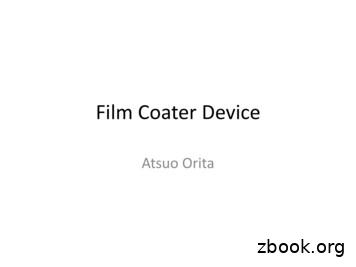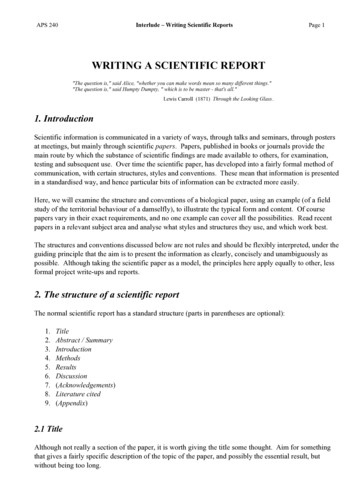Chapter 4 National Pesticide Applicator Certification Core .
CHAPTER 4Pesticide FormulationsChapter 4National Pesticide Applicator CertificationCore Manual
CHAPTER 4PesticideFormulationsThis module will help you: Recognize formulation abbreviations Identify formulation advantagesand disadvantages Understand role of adjuvants
Important Definitions Active Ingredient (Ai) - the actualchemical in the product mixture thatcontrols the pest Inert Ingredient - other materials addedwith the AI when the product is formulated Phytotoxicity - plant damage Adjuvant - product added to spray tank toassist pesticide in its application
Pesticide Formulationactive ingredient (Ai)each Ai will be listed inert ingredientswater, emulsifierssolvents, dry carrier materialstabilizers, dyesurfactants: spreaders, stickerswetting agents
Pesticide Spray BatchPesticide Formulation Water or oilSpray additives Adjuvants
Product Formulations Active and Inert IngredientsLexone DF Active IngredientMetribuzin (4-amino-6-1-1 dimethlyethly3-methythio 1,2,4,triazine 5 4H-one) Inert Ingredients TOTAL EPA Reg. No. 12333-34425%75%100%
Lexone DF Active IngredientMetribuzin25% Inert Ingredients TOTAL75%100%Lexone 2E Active IngredientMetribuzin* Inert Ingredients TOTAL * contains 2 lbs metribuzin per gallon25%75%100%
Why Add Inert Ingredients?1. For ease of pesticide product handling2. Inerts make measuring and mixingpesticides easier3. To provide for safety4. Makes the Ai work better Better penetration More selectivityUniv. of Missouri Increased effectiveness
Adjuvant The term adjuvant basically meansadditive (you need to memorize it) Formulation additive Additive which is soldseparately to mix with theproduct when tank mixing Labels will often recommend to add anadjuvant Include surfactants, spreaders, wettingagents, colorant dyes, buffers,antifoaming agents, safeners, etc.
Deciphering the Ai Code inProduct Names80SP80% active ingredientby weightSoluble Powder1EC1 lb Ai/gallonemulsifiable concentrate40DF40 % active ingred.Dry Flowable
Brand Name Abbreviations Often brand names include abbreviationsthat describe something about theformulationD–G–SP –S–WP –EC –DF –WDG –WSPdustULVgranularRTUsoluble powderGLsolutionLOwettable powderemulsifiable concentratedry flowablewater dispersible granule–––––water soluble packetultra low volumeready to usegellow odor
Selecting a Formulation Evaluate advantages and disadvantages Do you have the right applicationequipment? Can the formulation be applied when andwhere it is needed? Will the formulation reach the target pestand be there long enough?
Spray Mix Terminology solution suspension emulsionHow does it reallymix in the spraytank?
SolutionActive IngredientEither liquid or dry substanceTRULY dissolves in waterjust like sugar or whiskey in water*usually transparent*
SuspensionSolid particles suspended in a liquidlike hot chocolateActive Ingredient (high %)impregnated onto Dry Carrierand mixed with anEmulsifier (slick, soapy)
EmulsionOne liquid dispersed within another liquidlike milkAiOilAi is dissolved in oil (oil/ai droplet)and mixed with an emulsifierAi/Oil mixture is suspended inwater forming a white OilAIOil
Liquid FormulationsEmulsifiable Concentrate (E or EC)Active ingredient (liquid) dissolved in apetroleum-based solvent with anemulsifier addedproductdilutedTurnswhitewhenmixedSmells ofsolvents
Liquid FormulationsEmulsifiable Concentrate (E or EC)High Ai%ADVANTAGESDISADVANTAGES Easy to handle Little agitation Relatively easy onequipment Leaves little residue Phytotoxic – plant injury Easily absorbed by theskin Flammable Deterioration of rubberand plastic hoses
Liquid FormulationsSolutions (S)Ai dissolves in liquid carrier; once mixed withwater, solutions do not settle outproductdiluted
Liquid FormulationsSolutions (S)ADVANTAGES Easy to handleNo agitationEasy on equipmentNo residueUsed indoors/outdoorsDISADVANTAGES None
Liquid FormulationsReady-to-Use Low ConcentrateSolutions (RTU)Easy and relativelysafe to handleLess than 1% per unitvolume of activeingredient; high cost
Liquid FormulationsUltra-Low Volume (ULV) Special-purpose formulation Almost 100% active ingredient Agriculture, forestry, mosquito control
Liquid FormulationsUltra-Low Volume (ULV) ADVANTAGESDISADVANTAGESEasy to handleLittle or no agitationEasy on equipmentNo residueUsed indoors/outdoors High drift hazard Specialized equipmentneeded Solvent wear on rubberand plastic Calibration critical
Liquid FormulationsInvert Emulsions Oil carrier with water-solublepesticide – consistency ofmayonnaise Reduce drift and runoff Sticker-spreader Specialty uses: Rights-ofway and near sensitiveareas
Liquid FormulationsAerosols (A) Some are ready-to-use Little active ingredient High drift potential Some require highlyspecialized equipment Difficult to confine Respiratory protectionneeded
Dry FormulationsBaits (B)A bait is an example of a dry or liquid productthat is applied without mixing
Dry or Solid FormulationsBaits (B)ADVANTAGES Ready to use Coverage notcritical Control pest thatmove in and out ofareaDISADVANTAGES Attractive to children May kill domesticanimals and wildlife Dead pest odors Old bait may serve asfood source if inactive
Dry FormulationsPastes (P), Gels (GL)A bait formulated as a paste or gel that isapplied with a syringe or bait gun OdorlessMinimal exposureEasy to placeMelt at high temperaturesMay stain porous surfacesRepeat application cancreate unsightly buildup
Dry or Solid FormulationsDusts (D) and Granules (G) Ready-to-use Can reach hard to get placesAIdust Very little active ingredient Very fine, dry inert carrierAIgranule High drift potential Distribution and calibration a problem Dusts: Irritating to eyes, nose, throat, skin
Dry FormulationsGranules (G) and Pellets (P or PS)Granules Beads Pellets Granules: can be mistaken for food/feed
Dry Formulations Water Buy Dry -- Mix with water - Spray Wettable Powders (WP) Water Dispersible Granules (WDG) Dry Flowables (DF)Active Ingredient (high %)Dry CarrierEmulsifier (slick, soapy)
Dry FormulationsWettable Powders (WP or W)Wettable powders settle out quickly, thereforerequire constant agitation in the spray tankproductdiluted
Dry FormulationsWettable Powders – high Ai %ADVANTAGES Easy to store Easy to measure/mix Relatively less harmfulto plants, animals andsurfaces than ECs Less absorption byhuman skin and eyesDISADVANTAGES Inhalation hazard Constant agitation Difficult to mix in hardwater Abrasive to pumps andnozzles Visible residues
Dry FormulationsWater-dispersible Granules (WDG) orDry Flowables (DF)These materials possess some of the samecharacteristics as wettable powders except they areformulated into granular-sized particles, so are easier tohandle with little inhalation hazardproductdiluted
Dry FormulationsSoluble Powders (SP or WSP) Forms true solution, like sugar – noagitation Ai is 15-95% by weight Few pesticides are soluble powders
Dry FormulationsSoluble Powders – high Ai %ADVANTAGES Easy to measure/mix Form true solution Little phytotoxicityconcern Less absorption byhuman skin and eyesDISADVANTAGES Inhalation hazard
Liquid FormulationsFlowables (F) or Liquids (L)Flowables are basically a wettable powderpre-mixed with a liquid carrierproductdiluted
Other Formulations Microencapsulated High toxicity Ai inencased formulation Water-soluble packets No human exposurewhen mixing
Other Formulations Attractants/Repellents Impregnates Pesticide/FertilizerCombination Animal SystemicsUniversity of Kentucky
Other FormulationsFumigants Active as a poisonous gas,penetrates cracks, crevices,and stored commodities Highly toxic to all livingorganisms Very high risk of inhalationexposure Specialized protectionequipment; enclosed space
Pesticide Mixtures Tank mixing multiple products is legal unlessprohibited by the label Manufacturer only warranties their product alone orproduct mixtures listed on the label Manufacture notes known incompatibilities on label Incompatibility Heat, clumping, precipitate Inactivity of active ingredients Increased phytotoxicity Use Jar-Test to test for incompatibility Field incompatibility can still occur
Adjuvantspurchased additives to add to tank mixor added during formulation processSurfactants - groupOthers Wetting agents Spreaders Emulsifiers Stickers/ExtendersBuffersCompatibility agentsDefoaming agentsColorants/dyesSafenersThickeners
AdjuvantsHow to choose the right one? Read the pesticide label forrecommendations Some may prohibit use of an adjuvant Don’t use industrial products or householddetergents Test before you spend Remember, many pesticideproducts contain an adjuvant
CHAPTER 4Formulation Summary Active and inert ingredients Dry and liquid formulations Adjuvants Choose a pesticide formulation that willbest suit your pest problem and targetsite
CHAPTER 4Formulation Summary Choose a pesticide formulation that willbest suit your pest problem and target site Safety, ease of use Human exposure concerns Phytotoxicity; visible residues Application equipment considerations
CHAPTER 4Q1. Which of the following formulationstypically has the lowest rate of activeingredient?A.B.C.D.Dusts (D)Wettable Powders (WP)Emulsifiable Concentrate (EC)Soluble Powder (SP)
CHAPTER 4Q2. Which type of nozzle wouldpose a concern when using solublepowder formulations?1.2.3.4.no nozzle type poses a concernbrass nozzlesaluminum nozzlesnylon nozzlesA. 1 onlyB. 2 and 3 onlyC. 2 and 4 onlyD. 3 and 4 only
CHAPTER 4Q3. Which of the following areconsidered surfactant-type adjuvants?1.2.3.4.spreadersbufferswetting agentscolorant dyesA. 1 and 2 onlyB. 1 and 3 onlyC. 2 and 3 onlyD. 3 and 4 only
CHAPTER 4Acknowledgements Washington State UniversityUrban IPM and Pesticide SafetyEducation Program authored thispresentation Illustrations were provided byNevada Dept. of Agriculture,University of Missouri-Lincoln,Virginia Tech., Washington Dept. ofAgriculture, Washington StateUniversity
CHAPTER 4Acknowledgements Presentation was reviewed by Beth Long,University of Tennessee; Ed Crow,Maryland Dept. of Agriculture; JeanneKasai, US EPA; and Susan Whitney King,University of Delaware Narration was provided by Drex Rhoades,Washington State University InformationDepartment
CHAPTER 4Support for this project was madepossible through EPA Office ofPesticide Program cooperativeagreements with the Council forAgricultural, Science and Technology,and the National Association of StateDepartments of Agriculture ResearchFoundation. The views expressedherein are those of the authors and donot necessarily represent the viewsand policies of the EPA.
Pesticide Formulations Chapter 4 National Pesticide Applicator Certification Core Manual. CHAPTER 4 Pesticide Formulations This module will help you: Recognize formulation abbreviations Identify formulation a
National Pesticide Applicator Certification Core Manual. CHAPTER 12 Professional Conduct This module will help you: . of a certified applicator RESTRICTED USE PESTICIDE . National Pe
Elcometer 3530 Baker Applicator (Adjustable) Elcometer 3540 Bird Applicator Elcometer 3550 Bird Applicator Elcometer 3545 Bird Applicator (Adjustable) To maximise the benefits of your new Elcometer Film Applicator please take some time to read these Operating Instructions. Do not hesitate to contact Elcometer or your Elcometer supplier if you have
The Pesticide Applicator Report – Fall 2020 Page 4 of 18 to customers from disease vectoring pests. To respond to this need, PHARM staff devised a plan to proctor exams for essential services in accordance with Executive Order 01-20. COVID-19 Pesticide Applicator Exam (CO
Part One: Heir of Ash Chapter 1 Chapter 2 Chapter 3 Chapter 4 Chapter 5 Chapter 6 Chapter 7 Chapter 8 Chapter 9 Chapter 10 Chapter 11 Chapter 12 Chapter 13 Chapter 14 Chapter 15 Chapter 16 Chapter 17 Chapter 18 Chapter 19 Chapter 20 Chapter 21 Chapter 22 Chapter 23 Chapter 24 Chapter 25 Chapter 26 Chapter 27 Chapter 28 Chapter 29 Chapter 30 .
Film Applicator Bird Applicator and Baker Applicator Cylindrical film applicator with 4 application sides for applicating paint-films of 4 different pre-defined thicknesses. The Baker applicator’s are available in film width 60 mm 80 mm and are suitable for applying a host of different products onto flat and relatively solid substrates.
Applicator Certifications . ADOT staff who will be applying herbicides are required to pass the National Pesticide Applicator Core and Right-of-Way Category tests offered by PMD and become certified applicators. To earn a National Pesticide Applicator Certification, individuals m
Private Pesticide Applicator exam, and the Pesticide Consultants exam is based on the National Pesticide Applicator Certification Core Manual and this addendum. The learning objectives for each chapter of the addendum can be found at the beginning of each chapter. Questions on the exa
APS 240 Interlude Ð Writing Scientific Reports Page 5 subspecies of an organism (e.g. Calopteryx splendens xanthostoma ) then the sub-species name (xanthostoma ) is formatted the same way as the species name. In the passage above you will notice that the name of the damselfly is followed by a name: ÔLinnaeusÕ. This is the authority, the name of the taxonomist responsible for naming the .























